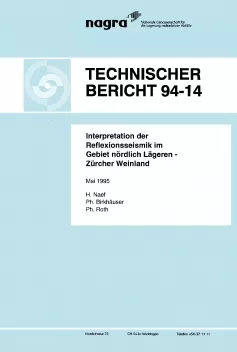
Technischer Bericht NTB 94-14
Interpretation der Reflexionsseismik im Gebiet nördlich Lägeren - Zürcher Weinland
The investigations of potential siting areas for a repository for high-level radioactive waste which are concentrated in the crystalline basement of Northern Switzerland have been expanded since the late 1980s to include suitable sedimentary units. After extensive desk study evaluation, the approximately 100m thick Opalinus Clay of the Tabular Jura east of the Aare river was chosen as the most promising sedimentary option. In this area not only the Opalinus Clay but also the over- and underlying units are clay-rich, in contrast to the Tabular Jura west of the Aare river. In the area North of Lägeren - Zurich Weinland, where the Opalinus Clay is situated in the optimum depth range of 400 to 1000m below surface, approximately 220km of new high-resolution seismic profiles were recorded and interpreted together with existing seismic lines.
Due to thorough field work and data processing, a very good quality of seismic lines was obtained. This allowed precise mapping of the marker horizons in general and the Opalinus Clay in detail. The goal of this study was to determine and delineate the most important tectonic units as well as to describe the potential host rocks in these units.
By way of interactive interpretation of all available seismic lines, borehole data and surface data from the investigation area, depth maps of the most prominent marker horizons have been calculated and geological cross-sections constructed along the new seismic lines. The regional seismic character of the Middle Mesozoic units was modelled using borehole data from Weiach and Herdern. From this model the thickness of the Opalinus Clay along the new seismic lines was determined. The results indicate a relatively constant thickness of 95 to 120metres in the investigation area.
The delineation of potential repository areas in terms of geology is based mainly on tectonic criteria and the depth of the host rock below surface. For a repository located in the depth range of 400 to 1000 m below surface, six regions each with a special tectonic situation can be defined in the area.
A In the Folded Jura the entire stack of sedimentary units above the basal detachment horizon is tectonically disturbed on a small scale. Because of this intensive deformation, the Folded Jura can be excluded as a potential repository zone without further investigation.
B Intensively disturbed zones in the area between the Folded Jura and the Tabular Jura in the so-called Precursory Folding Zone are limited to the Mesozoic units. However, even apparently undisturbed zones in this area may be disrupted by seismically non-detectable shear zones and cleavage, forming small-scale structures such as bending, wrenching and stretching, especially along ramp transitions.
The regions A and B can be excluded as repository options due to tectonic stresses.
C A high diversity of different structures on a small scale is likely to be found in the apparently undisturbed Opalinus Clay above compressively disturbed Triassic units in the Precursory Folding Zone. Anticlinal positions with extension structures Ooints & faults) alternate with synclinal positions characterised by shear zones and pressure solutions, causing a disturbance of the original layering within the entire unit. Basically, these areas cannot be excluded as potential siting regions. However, more detailed investigations would be necessary, which would lead to further high exploration costs.
D Sections with continuous uniformly layered Mesozoic within the Precursory Folding Zone can be directly compared with the Tabular Jura. However, the possibility of flat-lying shear zones, especially in the basal layers of the Opalinus Clay, has to be considered. These shear zones cannot be detected on the seismic lines.
E A comparison of the uniformly bedded Tabular Jura and the Plateau Molasse with the other areas suggests a simple tectonic history and therefore a small range of recognisable structures. The main structures are ruptures and faults with dislocations of a few tens of metres, which can be correlated with discontinuities in the underlying Permo-Carboniferous. These extensional faults often terminate within the Triassic formations. Within the ideal depth range for the repository in the area E, no seismically detectable disturbance of the Opalinus Clay has been found (see Appendices). Therefore, the area E is considered as the preferred siting location.
F Uniformly layered areas in the domain of the Bodensee Graben cannot be distinguished from those of the Tabular Jura, but generally they are limited to a few km2 and can only be poorly delineated due to insufficient data. Further uncertainties result from indications of recent horizontal dislocations producing compressive shear along existing fault planes. Therefore, this area can only be considered as being of limited suitability.
